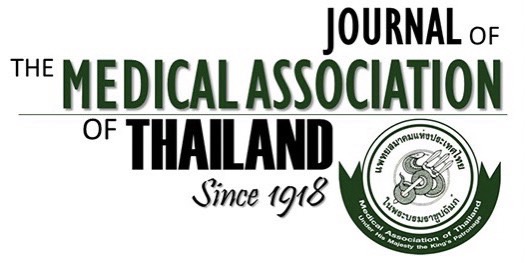Comparison of Hand-Sewn and Stapled in Esophagogastric Anastomosis after Esophageal Cancer Resection: A Prospective Randomized Study
Prakob Luechakiettisak MD*, Suppapong Kasetsunthorn MD*
Affiliation : * Department of Surgery, Suratthani Hospital, Suratthani
Objective : Compare the postoperative outcome of the hand-sewn method and the staple method of primary
esophagogastric anastomosis after esophagectomy in patients with esophageal carcinoma. The study focused
on leakage, stricture rates, operative time, blood loss, and complication.
Material and Method: A prospective randomized trial was undertaken in 117 patients with squamous cell
carcinoma of the thoracic esophagus who underwent Ivor-Lewis esophagectomy. Patients were classified
according to esophageal size, based on the diameter of the divided esophagus (< or > 30 mm) and then were
randomized to have primary anastomosis using either hand-sewn or stapled method.
Results : The mean total operating time of esophagectomy when using hand-sewn technique and staple tech-
nique were 218.1 + 47.8 minutes and 203.7 + 23.4 minutes, respectively (p = < 0.001). The mean blood loss
in the handsewn group and in the staple group was 864 + 346.6 mls and 803 + 301.2 mls, respectively (p =
0.02). Anastomotic leakage was 6.7% in the hand-sewn group and 3.4% in the staple group (p = 0.69).
Pulmonary and cardiac complications were 13.5% and 16.9% in the hand-sewn group compared with 17.2%
and 18.9% in the staple group (p = 0.77, p = 0.96). Anastomotic stricture was found in 10 of 52 patients
(19.2%) in the handsewn group and 19 of 52 patients (36.5%) in the staple group (p = 0.08). In the patients
with a small esophagus, the stricture rate was significantly lower in the hand-sewn group compared with the
staple group (15.2% vs. 38.8%) (p = 0.03). Mortality rate in both groups were not significantly different
(11.8% vs. 10.3%) (p = 0.97).
Conclusion : From the present study, it can be concluded that both hand-sewn method and the staple method
in primary esophagogastric anastomosis after esophagectomy in the patients with esophageal carcinoma
were safe. The stapled method had a higher incidence of anastomotic stricture especially small esophagus,
whereas it consumed less operative time and less blood loss.
Keywords : Hand-sewn technique, Staple technique, Esophagogastric anastomosis



